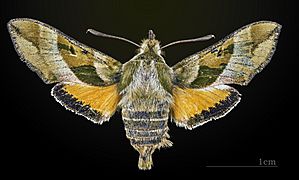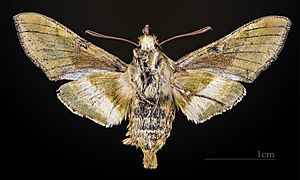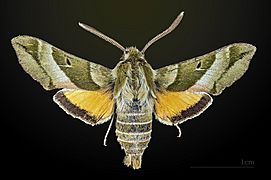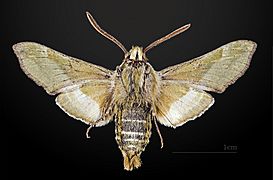Clark's sphinx facts for kids
Quick facts for kids Clark's sphinx |
|
|---|---|
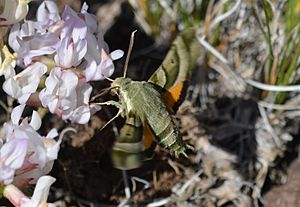 |
|
| Scientific classification | |
| Synonyms | |
|
The Clark's sphinx (scientific name: Proserpinus clarkiae) is a type of moth from the Sphingidae family. These moths are also known as sphinx moths or hawk-moths. This particular species was first officially described by a scientist named Jean Baptiste Boisduval in 1852.
You can find Clark's sphinx moths in North America. They live from British Columbia and Washington in the north. Their range extends south through California to Baja California in Mexico. They also live east into states like Idaho, Wyoming, and Utah. These moths prefer to live in places with oak trees and pine-oak forests, especially in hilly areas called foothills.
What Does It Look Like?
The Clark's sphinx moth has a wingspan (the distance from one wingtip to the other) of about 30 to 38 millimeters. That's roughly the length of two or three small paperclips!
If you look at the underside of their front wings, you might notice that the orange color near the base is very faint or even missing. The top side of their back wings is usually a pale orange or yellowish color. These back wings also have a black band along their outer edge.
Life and Habits
Adult Clark's sphinx moths are active from mid-March to June. They usually have just one generation of moths each year. During this time, they fly around and feed on nectar from many different kinds of flowers.
Some of their favorite flowers include:
- Salvia columbariae (Chia)
- Asclepias cordifolia (Heart-leaf milkweed)
- Ribes aureum (Golden currant)
- Dipterostemon capitatus (Blue dicks)
- Clarkia species (like Farewell-to-spring)
- Vicia species (like Vetch)
- Cirsium species (like Thistle)
- Stachys species (like Hedgenettle)
The young moths, called larvae or caterpillars, have a specific plant they like to eat. They feed on Clarkia unguiculata, which is also known as Elegant Clarkia or Mountain Garland.


